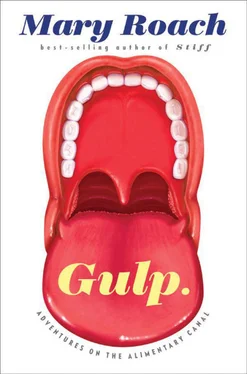SILLETTI HANDS ME a plastic cup and sets a timer. We are moving on to unstimulated saliva. This is background saliva, the kind that’s always flowing, though much more slowly. A minute passes. We turn away from each other and quietly spit in our cups.
“Look at the difference, compared to stimulated.” Silletti tilts her cup. “You can’t pour it easily. It’s so viscous. Look!” She dips the end of a glass pipette into her sample and pulls it away. Filament is a nice word, Silletti’s word, for the mucoid strand that trails behind.
Relatively little is known about unstimulated saliva. Partly, Silletti says, because no one wants to work with it.
“Because it’s so gross?”
“Because it’s harder to collect. And you can’t filtrate it. It clogs the filter, like hair in the drain. And you cannot be precise, because it’s so slimy.”
“Right, it’s gross.”
Silletti tucks a strand of her glossy black hair behind her ear. “It’s difficult to work with.”
Unstimulated saliva’s trademark ropiness is due to mucins, long chains of amino acids repeating to form vast webs. Mucins are responsible for saliva’s least endearing traits—its viscosity, elasticity, stickiness. [43] But not its bubbles. Frothiness is a hallmark of proteins in general; saliva has more than a thousand kinds. Proteins bind to air. When you whip cream or beat eggs, you are exposing maximum numbers of proteins to air, which is then pulled into the liquid, forming bubbles. That disturbing white foam on the cheeks and necks of racehorses is saliva whisked by the bit. (The whisking of semen is complicated by its coagulating factor. Should you wish to know more, I direct you to the mucilaginous strands of the World Wide Web.)
They are also responsible for some of its more heroic attributes. Unstimulated saliva forms a protective film that clings to the surfaces of the teeth. Proteins in this film bind to calcium and phosphate and serve to remineralize the enamel. Webs of mucins trap bacteria, which are then swallowed and destroyed by stomach acids. This is good, because there are a lot of bacteria in your mouth. Every time you eat something, every time you stick your finger in your mouth, you’re delivering more.
Picture one of those little silver [44] Literally. The coating is real silver. That’s why the label says “For Decorative Use Only.” Like everyone else, environmental lawyer Mark Pollock didn’t realize you weren’t supposed to eat them. In 2005, Pollock sued PastryWiz, Martha Stewart Living Omnimedia, Dean & DeLuca, and a half-dozen other purveyors of silver dragees, as they are known in the business. Pollock succeeded in getting the product off store shelves in California. Fear not, holiday bakers, silver dragees are available in abundance from online sellers, along with gold dragees, mini dragees, multicolored pastel dragees. And dragee tweezers. (With cupped ends “to easily grab individual dragees.”)
balls that cake decorators use. Strip away the metallic coating and soften the texture. You are now picturing the amassed bacteria in one milliliter of unstimulated saliva. Silletti put our samples in the centrifuge and spun cellular from noncellular. Some of what we are looking at is shed mouth cells, but most is bacteria—about a hundred million of them. More than forty species.
Yet never in my life has a cut or sore in my bacteria-crazy mouth become infected. As much as saliva is a bacterial cesspool, it is also an antimicrobial miracle—the former necessitating the latter. As a germ killer, saliva puts mouthwash to shame. [45] As does this: Claims made by makers of mouthwash to kill 99 percent of oral bacteria are misleading. Silletti says half the species can’t be cultured in a lab; they grow only in the mouth. Or on other bacteria. “When you ask the companies for claim support, they will show you the statistics for the kinds they can culture.” How many others there are, or what mouthwash does to them, is unknown.
Saliva has anti-clumping properties, which discourage bacteria from forming colonies on the teeth and gums. There are salivary proteins that retain their antimicrobial abilities even when they themselves are broken down. “And they may be even more effective than the whole protein of origin,” Silletti is saying. “It’s incredible!”
Saliva’s antimicrobial talents explain some of the folk medicine remedies that have been making the rounds since the 1600s. One 1763 treatise advocates applying “the fasting saliva of a man or woman turn’d of seventy or eighty years of age” to syphilitic chancres of the glans penis. As with the ancient Chinese Materia Medica prescription of saliva “applied below arms to counteract fetid perspiration,” one imagines— hopes —that an applicator other than the tongue was employed.
“It is a known observation among the vulgar that the saliva is efficacious in cleansing foul wounds, and cicatrizing recent ones, thus dogs by licking their wounds… have them heal in a very short time,” wrote the eighteenth-century physician Herman Boerhaave. He was correct. Wounds that would take several weeks to heal on one’s skin disappear in a week inside the mouth. In a 2008 rodent study, animals that licked their wounds healed faster than those that could not (because their salivary glands had been disconnected—a wound, alas, that even saliva cannot heal).
More than just disinfecting is going on. Rodent saliva contains nerve growth factor and skin growth factor. Human saliva contains histatins, which speed wound closure independent of their antibacterial action. Dutch researchers watched it happen in the lab. They cultured skin cells, scratched them with a tiny sterile tip, soaked them in the saliva of six different people, and clocked how quickly the wounds healed, as compared to controls. Other components of saliva render viruses—including HIV, the virus that causes AIDS—noninfective in most cases. (Colds and flus aren’t spread by drinking from a sick person’s glass. They’re spread by touching it. One person’s finger leaves virus particles on the glass; the next person’s picks them up and transfers them to the respiratory tract via an eye-rub or nose-pick.) [46] In 1973, inquisitive cold researchers from the University of Virginia School of Medicine investigated “the frequency of exposure of nasal… mucosa to contact with the finger under natural conditions”—plainly said, how frequently people pick their nose. Under the guise of jotting notes, an observer sat at the front of a hospital ampitheater during grand rounds. Over the course of seven 30- to 50-minute observation periods, a group of 124 physicians and medical students picked their collective noses twenty-nine times. Adult Sunday school students were observed to pick at a slightly lower rate, not because religious people have better manners than medical personnel, but, the researchers speculated, because their chairs were arranged in a circle. In a separate phase of the study, the researchers contaminated the picking finger of seven subjects with cold virus particles and then had them pick their nose. Two of seven came down with colds. In case you needed a reason to stop picking your nose.
The average person, of course, is oblivious to all this. With no more formal criteria than the number of Hollywood monsters featuring copious, pendant drool, you can make the case that saliva remains universally upsetting. And thus maligned, even in the medical community. There has long been an assumption among emergency medical personnel that human bites are especially likely to become infected and lead to sepsis—a potentially lethal systemic infection. “Even the simplest of wounds require copious irrigation and wound toilet,” warn the authors of “Managing Human Bites” in the Journal of Emergencies, Trauma, and Shock.
Читать дальше












